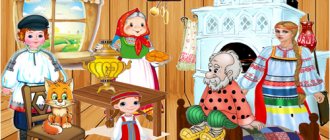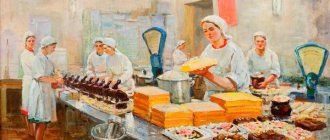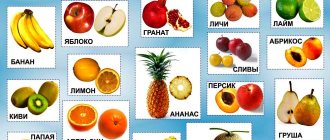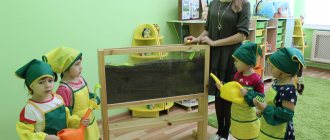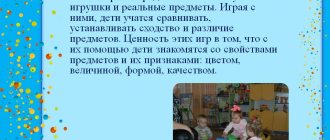What children need to know about emotions
By the senior preschool age, the child has already formed an idea of human emotions, which include:
- joy
- sadness
- fear
- anger
- resentment
- astonishment
Children define and name psychological states, briefly describe them, and give examples of everyday situations in which a person experiences them.
Pictures for children depicting emotions teach the child to reason, describe cause-and-effect relationships, and analyze his own life experience.
During speech therapy work, it is useful to offer preschool children topics related to people’s experiences to compose narrative stories. For example:
- Is it only humans who have feelings?
- What are positive and negative emotions?
- When am I happy and when am I sad?
Emotions can be divided into pairs with opposite meanings. For example: joy - sadness, disgust - admiration, boredom - interest, etc. Children should be able to recognize and name the feeling of the character in the picture, but also select antonyms for the definition. Exercises in this format allow you to more firmly consolidate the characteristics of emotions.
Children should know that we can learn about a person’s psychological state both from words and by observing actions and behavior. Each emotion has a corresponding dictionary and a set:
- gestures
- facial expressions,
- actions
It is useful to have conversations with older preschoolers about how their emotional state needs to be managed, especially when it comes to negative feelings. You cannot give free rein to anger, irritation, or sadness. Express feelings only in socially acceptable ways. Children will be interested to know that in countries around the world people express feelings in different ways.
Development of a child’s coherent speech - download tasks
The development of coherent speech is the main, advanced point in the development of communicative abilities and maturation.
Through the speech apparatus, the child learns to communicate. A vocabulary and the ability to convey feelings and thoughts become the key to comfortable learning and perception of the world. Poor development of coherent speech in preschoolers often causes hysterics and worries parents. The childdevelop website presents exercises for the development of coherent speech, developed by experienced teachers, psychologists and speech therapists. The author's methods and visual exercises for the development of coherent speech will be beneficial and useful.
Defining emotions for children
For speech therapy work with students in the senior and preparatory groups of kindergarten, use the following list of emotional states:
Joy is a positive emotion familiar to everyone. We feel joy when something good happens. A person can express this feeling through words and actions. Signs of a joyful state are laughter and smiling. Experiencing joy feels good, as does bringing it to others.
Sadness is a feeling that appears when we learn or think about something sad. Sadness cannot be called a strong emotion; it passes quickly. This does not mean that you should not allow yourself to be sad; sometimes every person needs it. But you shouldn’t indulge too much in a sad mood; it’s more useful to try to quickly get rid of it by doing something pleasant or useful.
Anger is anger, strong irritation towards someone or something. Feeling angry is not pleasant, but sometimes it happens to everyone. It is a strong emotion that can cause trouble for us and others. It is important to explain to children how to manage anger and be able to express it correctly. If a person is often angry, then it is difficult for him to find friends, he is often lonely.
Fear is a strong negative emotion that people experience if they are threatened by something. The danger can be real or expected or imaginary. Every child has repeatedly felt fear, so he can easily recognize its image in illustrations or photographs, and also give examples of events, objects and phenomena that cause this feeling in them. Children should know that fear varies in intensity, from fear to horror. It is important to explain to children that this emotion is necessary for a person, as it warns of danger. It can be added that the color black is often used to illustrate fear in pictures.
Admiration is a pleasant emotion that arises when encountering something very beautiful or unusual. Admiration can be caused by: an unusual toy, a garden in bloom, an elegant girl. People, expressing admiration, use special exclamations: (oh, ah, wow, wow) and words (really, amazing, wonderful, wonderful, extraordinary). Admiration can be so strong that it is very difficult to express your feeling in words. From a photograph or drawing, preschool children can easily recognize a person who admires something, although it is difficult for them to describe his feelings; this requires special speech therapy training.
Shame is an unpleasant feeling that occurs when we have done something bad and regret it. The older the children, the easier it is to explain to them the essence and meaning of this emotional state. Signs of shame are not only certain facial expressions, but also redness of certain parts of the face (cheeks, ears, neck). Knowing this feature will help preschoolers quickly and easily recognize shame in drawings (by the way, this sign can often be seen in story pictures for children and even in selfies) and in the behavior of people around them. You can have a conversation with children 6-7 years old about the difference between shame and shyness; these states are easy to confuse.
Resentment - a person feels resentment when someone’s action seems unfair to him. Some people are touchy, others rarely experience this emotion. It is difficult to describe the state of resentment; preschool children should be able to recognize its image. To do this, you can use both schematic images (for example, emoticons - simple pictures of emotions for children), and realistic drawings, color or black and white photographs. By the way, it is convenient to print such visual material from collections and presentations on specialized speech therapy websites.
Drawn pictures
Emotions in pictures for children, used for classes on speech development, are presented in several versions: images of adults and children, people or fairy-tale characters. Printed pictures and drawings created by children are suitable for the development of speech in preschoolers.
Invite the children to draw themselves or another person experiencing a certain feeling. Drawing up a verbal explanation for such a picture is a speech therapy exercise that the children do willingly.
If children are not yet able to cope with independent depictions of emotional states, it is worth inviting them to create a collage from pre-prepared and printed facial details. Preschoolers aged 6-7 years are able to recreate emotions on paper on their own, but for younger children it is worth using ready-made templates and samples.
In speech therapy work, you can use not only drawing, but also coloring. Thematic coloring books are a useful and exciting material that is indispensable for girls and boys in kindergarten and at home.
It is important to first thoroughly study with children not only the names of different emotions, but also those artistic techniques that allow you to accurately convey one or another psychological state of a person. The use of pictograms can be very helpful in this regard.
DIY didactic games for speech development for children 4-7 years old
DIY didactic games
on speech development for children 4-7 years old
Didactic game "Seasons"
This game is intended for use with children aged 3 to 7 years.
Purpose of the game:
to help clarify and expand preschoolers’ ideas about the seasons, seasonal changes occurring in living and inanimate nature, the development of connected speech, and cultivate interest in cognitive and play activities. Each age group has its own version of the game.
Didactic game «
Seasons
"
has a developing, educational and educational meaning. It can be used in almost any type of children's activity. This game is perfect for individual, subgroup and frontal work with preschoolers.
Material:
4 pictures depicting the seasons, and cut cards with signs of the seasons.
The game must be preceded by a conversation.
For example:
In winter the days are short. The sun is low and warms weakly. Snow falls. Cold. People wear winter clothes. In winter we celebrate everyone's favorite holiday - New Year.
In spring, the days become longer. The sun is warming better. It is getting warmer. Snow is melting. Streams are flowing. Leaves appear on the trees. Grass begins to grow. Flowers are blooming. Migratory birds arrive. People wear demi-season clothes. In the spring we celebrate everyone’s favorite holiday - March 8th
In summer the sun is high, shines brightly, and warms well. The weather is hot. Flowers bloom and berries appear. People wear summer clothes. You can swim in natural reservoirs and sunbathe.
In autumn, the days become shorter and shorter. The sun is lower. It's getting cooler. The vegetable harvest is ripe. Leaves are falling from the trees. Migratory birds fly south. It rains often. People wear warm clothes. The most famous autumn holiday is the Day of Knowledge.
Game task
is to put cards with signs of the season in the windows of the corresponding card and explain your choice.
Rules of the game:
Large cards are given to the participants of the game. Small cards are laid out on the table. Children take turns taking one card at a time and see if this card is suitable for a large card, if there is such a sign for this time of year. If not, the small card must be placed back on the table. The first one to close all the windows wins. The game can be used both in classes and in children’s free independent activities.
Each age group has its own version of the game.
Didactic game
“Cleaning the room: put it on the shelves”
Purpose of the game:
promote the development of logical thinking, memory, speech, the ability to generalize and justify.
Didactic task:
Exercise children in classifying objects. The child is required to find a group of similar objects, primarily by purpose, and arrange them on the right shelves.
Materials:
a box in the shape of a cabinet with shelves and cut cards with objects.
Progress of the game:
We lay out cards with drawn objects in disarray on the table. We invite the child to do the cleaning. You need to arrange items on shelves according to their purpose and name the group (clothing, dishes, toys, shoes, household chemicals, medical supplies).
Didactic
game
“Carlson Away”
The goal of the game:
consolidating the use of relative adjectives and the method of their formation in children’s speech, activating the vocabulary of adjectives.
Materials:
A large card with Carlson and the Kid and small cards with images of treats (jam, sweets, juice).
Progress of the game:
Children take turns taking small cards and calling out the treats.
For example:
Imagine that Carlson came to visit us. He has a great sweet tooth, and we need to treat him with something tasty.
What can we treat Carlson to? Jam! What kind of jam? Banana (orange, strawberry, etc. - put the desired card). What else can we treat Carlson to? Sweetie! What kind of candy? Banana (orange, strawberry, etc.). ... Juice. Banana, orange, strawberry juice.
Didactic
game
“My, my, mine, mine”
Target:
exercise children in classification, correlating nouns of masculine, feminine, neuter gender; enriching the vocabulary by selecting words; teaching children to agree nouns with possessive pronouns my, mine, mine, mine.
Rules of the game
consist in the correct selection by participants of cards with images of characters and objects, the name and names of which must be ordered in accordance with masculine, feminine, neuter genders.
Materials:
Large cards of four and small cards with objects
The cards depict a Hedgehog with an apple and small cards depicting objects
Progress of the game:
Cards are placed on a special field, separate for each type. After finishing sorting the cards by gender, the children must explain their choice. Children are invited to put pictures on the apple windows called “Mine, mine, mine, mine.”
Be sure to say at the same time, for example: “my fish.”
Didactic
game
“He, she, they, it”
Target:
exercise children in classification, correlating nouns of masculine, feminine, neuter gender; enriching the vocabulary by selecting words; teaching children to agree nouns with pronouns he, she, they; and also to develop in children the ability to distinguish the gender of possessive pronouns mine, mine, mine.
Rules of the game
consist in the correct selection by participants of cards with images of characters and objects, the name and names of which must be ordered in accordance with masculine, feminine, neuter genders
Children are invited to arrange the pictures into houses called “He”, “She”, “They”. The child puts pictures about which one can say “my” in the house called “He”, pictures about which one can say “mine” - in the house “She”, “mine” - “It”.
Didactic game
"Sound Clock"
(how the words differ).
This didactic game will help you figure it out and understand that one single letter can change the meaning of an entire word.
This game is perfect for individual, subgroup and frontal work with preschoolers
Each age group has its own version of the game.
Target:
consolidate, clarify and activate children’s knowledge about the spoken word
And thunderous material:
large size “Sound Clock” manual and cards with objects.
Option 1. (for children 4-5 years old)
Rules of the game:
1.Say the names of the objects depicted.
2. Find two word names that sound similar and point to them with the hands of a clock.
3. Find two words - names that are not similar in sound and point to them with the hands of a clock.
4. Find two short words, indicate with arrows, and vice versa - two long words.
5. Find two word names that begin with the same sound.
Option 2. (for children 4-7 years old)
Rules of the game:
1. Select and name the first and last sound in the names of the pictures.
2.Name first those pictures that begin with voiced consonants, then with voiceless ones.
3. Determine what is the first and last sound in the name of the picture: hard or soft consonant, vowel.
4.Choose words that begin with the same sound as the name of the picture pointed to by the small arrow.
5. Find words ending with the same sounds as the name of the picture, which is pointed to by the small hand of the clock.
6. Come up with phrases consisting of two, three and four words, be sure to include the names of those pictures that the small hand of the clock points to.
Didactic game
“Guess the word”
(puzzles for preschoolers)
Read by first letters is a very fun and entertaining game for children aged 5-6 years, which also develops reading skills. These are the simplest puzzles. The game develops memory, attention, logical thinking, phonemic hearing. The game reinforces the ability to identify the first sound in a word and write it using a letter, reading skills, and sound-letter analysis. Target:
to train children in identifying the first sound in words and composing words, to promote the development of phonemic hearing.
Game material:
cards with pictures, a set of letters and symbols (blue, green and red squares)
Didactic task:
Having identified the first sound in the name of each picture, guess the word and read it (lay out the word with symbols and letters)
Progress of the game:
Children solve the word by identifying the first sound and lay out the word using symbols and letters.
Didactic game
"Treat the animals"
Target
:
practice dividing words into syllables, finding long and short words (forming an idea of the syllabic composition of a word).
And thunderous material:
Three large cards depicting a spruce, a birch and a bush, cards with pictures
.
Progress of the game:
The teacher suggests:
1. put words-delicacies for forest dwellers under a bush, fir tree and birch. Under the bush you need to put words consisting of one syllable, under the Christmas tree words consisting of two syllables, but under the birch tree words - of three syllables.
To do this, you need to determine the number of syllables (parts) in a word.
Children:
Apple. The word apple has three syllables. The first syllable is YAB. I will put it under a birch tree (you can clap the word).
2.Name the shortest word. Find the longest word
Didactic game
"Syllable watch"
This is an interesting, entertaining game for children 5-7 years old that develops reading skills. The game develops memory, attention, logical thinking, phonemic hearing. The game reinforces the ability to identify syllables in a word and contributes to the development of sound-letter analysis of the word.
Target:
practice composing words from syllables;
Game material:
manual "Syllabic clock"
Rules of the game:
Using syllables, game participants form words that are encrypted in the manual and place arrows on them (you need to add another syllable to one syllable, so we get a word).
Syllables: KO-PA - RA -SA -TY - LA - FOR - LI
As a result, we get the words :
fox, Lisa, linden, goat, bark, braid, cats, couple, Lara
Didactic game
"Magic Circle"
Target:
exercise in identifying the first sound in a word, promote the development of phonemic awareness. Continue to expand children's vocabulary through the use of qualitative, possessive and complex adjectives. Continue to practice the formation of different degrees of comparison of adjectives, adverbs and the use of nouns in the instrumental case.
Game material:
manual "Magic Circle"
Rules of the game:
The tool consists of four rotating wheels. On the first circle there are cubs. on the second - the mothers of the cubs, on the third - the house (dwellings), - on the fourth - parts of the animal’s body: tails, paws, fur.
Children spin the wheel and find the mothers their cubs, a home, identify parts of the animal’s body, and thus answer questions :
Who with whom? Where live? Whose House? What part of the body is this? Whose tail? Whose paws?
Children's answers:
A little fox and a fox live in a hole. Fox hole, fox tail
IN:-
And if a fox has a long tail, does that mean what kind of fox is it? - long-tailed
IN:-
And if a hare has a short tail, what kind of hare does it mean? - short-tailed
IN:-
The wolf's tail is long, and the fox's tail is even……longer, more…. long
IN:-
The bear has a tail…..small, and the bunny has an even….smaller tail.
Pictograms
Schematic representations of various emotions greatly help children in learning, remembering and recognizing human emotional states. Especially in the early stages of getting to know this topic. Various sets of “Emotions emoticons pictures for children” contain cards with a conventional image of anger, joy and other feelings.
Games with pictograms
Games with pictograms are a whole area in the work of speech therapists and psychologists. Schematic images of emotions (faces) are excellent material for stimulating a child’s speech activity. Here are some examples of using such images:
Pick and name
Prepare pictures of pictograms with different emotions and feelings for children. The task is to find out this or that state, give it a name, and then come up with a situation in which it would be appropriate. Children can use both their personal experience and remember the heroes of famous fairy tales and cartoons. It’s okay if at first the descriptions of emotions sound childish, gradually regular speech training will help these stories become more perfect.
Find a match
If you take a cut set of emoticon pictures and mix them up, you will get an exciting game for a team of preschoolers, which can also be used in speech development classes. The task is to collect all the images. It is important that each emoticon accurately expresses a particular feeling, then the emotion will be easier to recognize and describe.
Transformations of moods
For this game you need to select the following emoticons, pictures of emotions for children, which can be sorted into opposite pairs. For example, sadness-joy, admiration-disgust, etc. Ask the children to take one card or a round smiley face, and then match the selected picture with a pair. After this, you can invite the children to come up with a story about what could turn one emotion into another.
Koloboks
The image of a kolobok is similar to a smiley face, so also use pictures with this character as pictograms illustrating emotions.
Use Kolobok’s drawings on a transparent background, so it’s easier for children to analyze the psychological state of the hero, and not the plot twists that happen to him.
There are many options for games with this fairy-tale character. For example, tell a Russian fairy tale, describing the emotions of Kolobok and other characters. The use of puppet theater or masks will help make this activity productive.
Emotions in the country of Smeshariya
Toys from the cartoon Smeshariki - material for classes on speech development in preschool educational institutions and at home. Images of funny round characters can be used to illustrate emotional states. Buy a ready-made manual or make it yourself, cutting out and signing characters from a magazine or book.
Offer the children pictures of Smeshariki and ask them to name the feeling that Nyusha, Kar-Karych, Krosh and other characters experience.
Pictures for speech development
Picture 1 This is Tanya and Vanya. They are brother and sister. One day Tanya and Vanya woke up and looked out the window. Oh, what beauty! Someone drew patterns on the glass. And outside the window... a white fur coat covered the whole world. What is this? That's right, there is snow on the branches. So, she came... (Talk to the child about the snow, frosty patterns on the glass, about bullfinches, about rowan trees, about trees that have shed their leaves.)
Picture 2
Tanya and Vanya love to play outside in winter. Do you love? Hurry up to the street! Tanya and Vanya are great, they dress themselves. Vanya put on overalls, but what is Tanya wearing? (Fur coat.) Do you like Tanya’s hat? Who has a better hat, Tanya or Vanya? What kind of hat do you have? What do you wear when you go out? (Talk with your child about winter clothes, their types, colors, etc.)
Picture 3
Who is this rushing on a sled down a snowy hill? (Tanya.) Do you think Tanya likes sledding? Where is Vanya? See how well he skis. I just lost my sticks somewhere. But look how he waves his hands! A real skier! What do you like to do more: skiing or sledding? (Talk to your child about the boy on the snow scooter, about your downhill ride, etc.)
Picture 4 Oh, there's so much snow outside! What big snowflakes are flying! Here is Vanya. He rolls a big ball. What did Tanya blind? Look what the snowman has instead of a nose? What kind of snowman do you think Vanya will build? (Wait for the child’s full answer.) What do you like to sculpt from snow? (Draw snowflakes, a snowman, and footprints in the snow on a white or blue sheet of paper.)
Picture 5 It's cold in winter. It is difficult for birds and animals to find food. But they do not lose heart - how joyfully they fly and jump from branch to branch. Yes, and we will help them - we will treat them with something, right? You see, Tanya brought seeds for the birds, and Vanya brought a nut for the squirrel. Well done Tanya and Vanya! (Continue the conversation: what birds does the child know, what berries hang at the feeder, etc.)
Picture 6
In winter there is a very cheerful holiday. Do you know which one? That's right, New Year. For the New Year, they decorate the Christmas tree with shiny toys and light colorful lights on it. Do you like decorating the Christmas tree? Look what a beautiful Christmas tree. Who's near the Christmas tree? (Wait for the child’s detailed answer.) See how smart the children are! And they dance so fervently! Let's find Tanya and Vanya among them. (Look at the toys on the Christmas tree, find out who the kids dressed up as, remember or dream about your holiday.) Thank you, winter, winter, for the holiday!
Picture 7 Who came to the guys for the holiday? (Talk about where Santa Claus lives, what kind of beard and clothes he has, how kind he is, how he loves children.) What does he have in his bag? Do you like Snow Maiden? What is she wearing? What gifts did Father Frost and Snow Maiden bring to Tanya and Vanya? What gift did you get for New Year?
